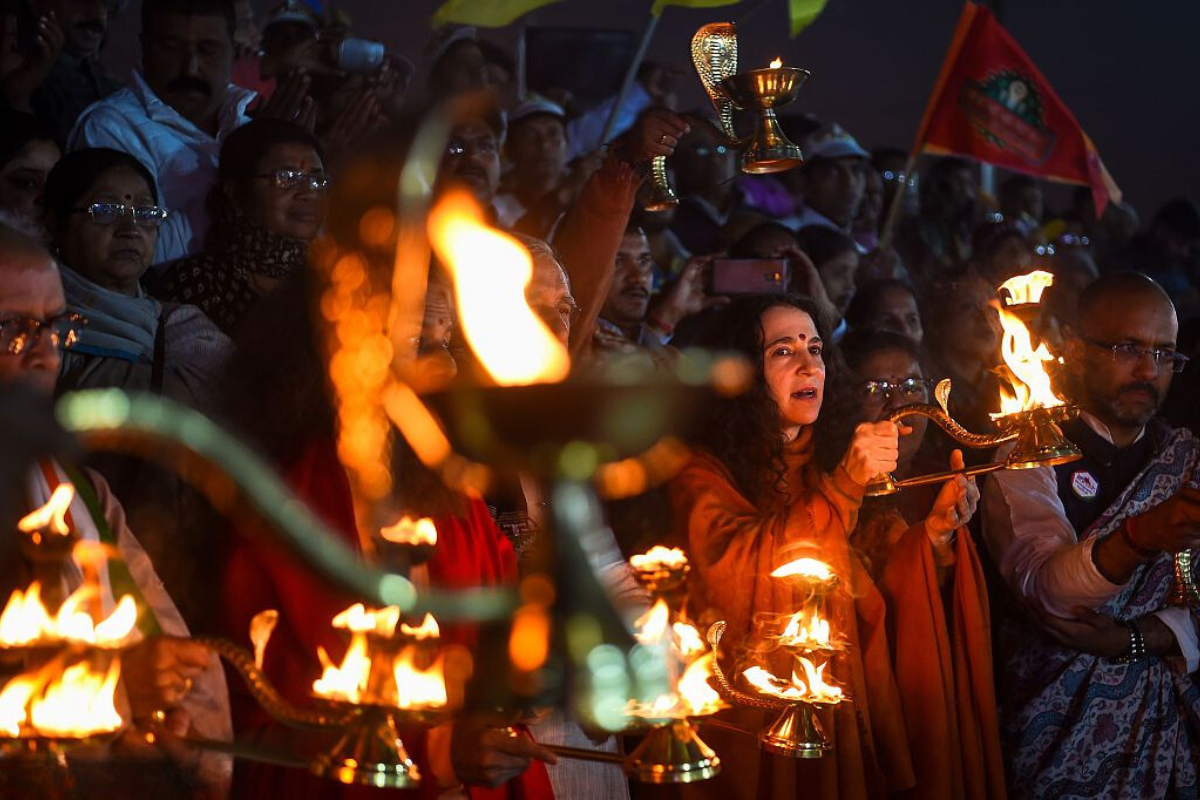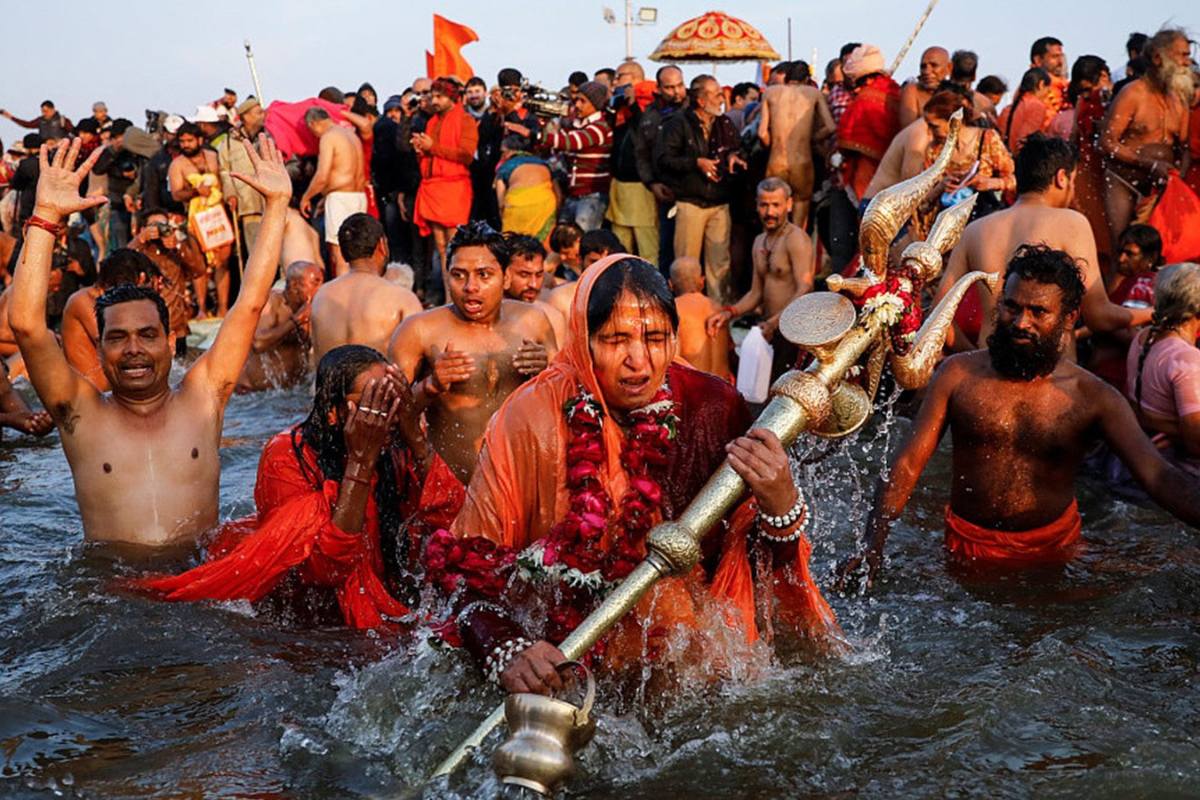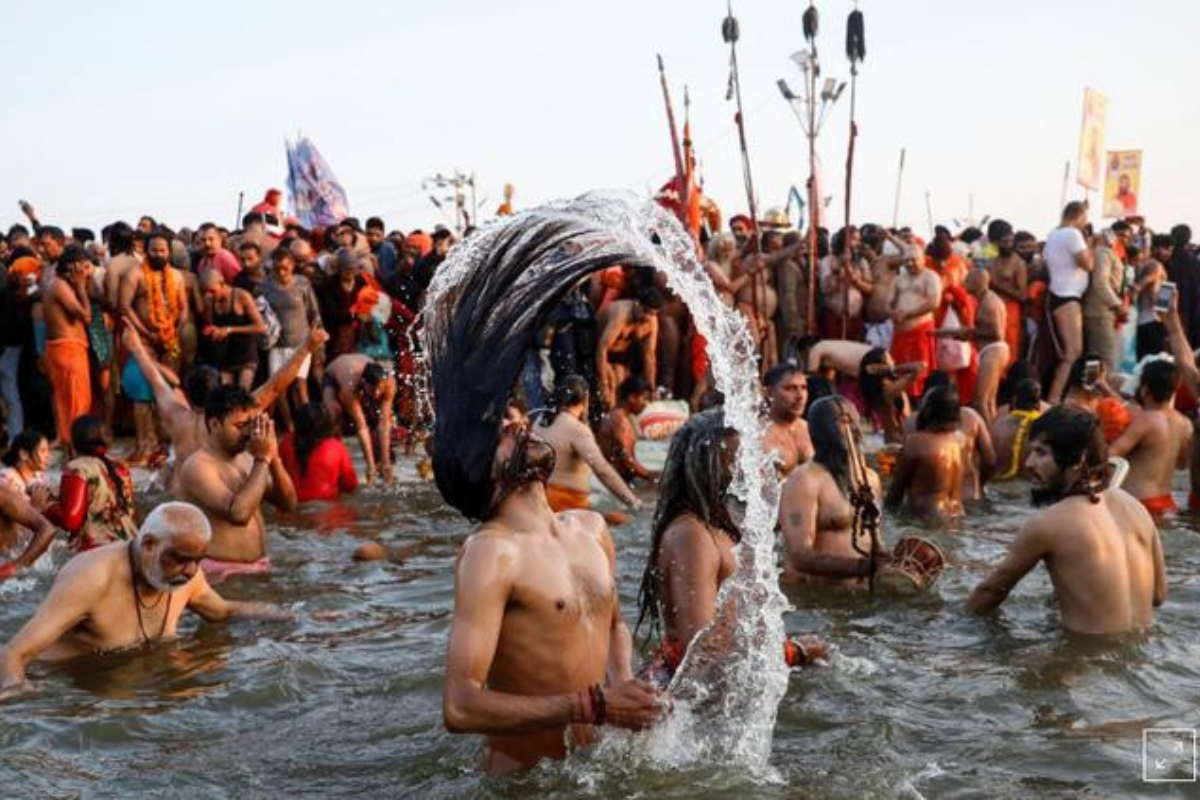The Kumbh Mela, meaning “festival of the pot,” is a Hindu pilgrimage and festival unlike any other. It is the largest peaceful gathering of humanity on Earth, attracting millions of devotees every year. This 12-year cycle of four distinct Melas, each held in a different location along sacred rivers, is a vibrant tapestry of faith, tradition, and cultural expression.

Photo: CGTN
The Kumbh Mela’s history stretches back millennia, deeply rooted in Hindu mythology. The legendary tale of the Samudra Manthan, the churning of the cosmic ocean, serves as the foundation for the festival’s significance. As the story goes, the gods and demons joined forces to churn the ocean of milk, seeking the Amrita, the divine elixir of immortality.
During this momentous churning, fourteen precious objects emerged, including the Amrita. However, a fierce conflict erupted between the Devas and Asuras over possession of the elixir. Lord Vishnu, the preserver god, intervened in the form of Mohini, an enchanting enchantress. He, disguised as Mohini, skillfully distributed the Amrita amongst the devas, ensuring their victory and securing their immortality.
However, during the distribution, a few drops of the Amrita spilled onto the Earth, landing on four specific locations. These four sites, consisting of Haridwar, Ujjain, Nashik, and Prayagraj, are now considered the sacred venues for the Kumbh Mela. Each drop is believed to have imbued the respective rivers with immense spiritual power, marking them as holy pilgrimage destinations.
The Kumbh Mela, therefore, is a symbolic representation of the ongoing pursuit of spiritual liberation. The belief associated with the sacred baths, held during the auspicious dates determined by planetary alignments, is that they offer the opportunity to wash away sins and pave the way for moksha, liberation from the cycle of rebirth. This deep-rooted faith, coupled with its rich mythological origins, continues to draw millions of pilgrims to the Kumbh Mela, perpetuating its legacy for centuries to come.

Photo: CGTN
A multifaceted celebration: Beyond the ritual bath
The Kumbh Mela transcends the singular act of ritual bathing to encompass a vibrant tapestry of cultural experiences. Spanning over several weeks, the festival explodes with diverse dimensions, offering a glimpse into the rich soul of India.
At its heart, the Kumbh Mela remains deeply rooted in faith. Pilgrims undertake sacred baths known as “shahis” on specific, auspicious dates determined by a complex astrological calendar. Apart from dipping in the water, these shahis are meticulously followed rituals imbued with deep meaning. Chants resonate through the air, accompanied by devotional songs and fervent prayers. This potent mix creates a powerful spiritual atmosphere where every action carries significance and strengthens the pilgrims’ connection to the divine.
The Kumbh Mela is a vibrant kaleidoscope of Indian culture, showcasing its remarkable diversity. Sadhus, adorned in saffron robes and smeared with ashes, mingle freely with families, residents, and even international visitors. The air buzzes with a cacophony of languages and dialects, highlighting the festival’s inclusivity. Akharas, processions of various religious orders, snake through the streets, their vibrant banners and rhythmic chants adding to the festive spirit. Every corner pulsates with a unique blend of traditions, customs, and beliefs, offering a window into the multifaceted cultural fabric of India.

Photo: BBC
The Kumbh Mela transcends the limitations of religion, fostering a sense of social harmony and unity. People from all walks of life, regardless of their social status, caste, or creed, come together as equals, united by their faith and shared humanity. This sense of community transcends religious boundaries, offering a platform for interfaith dialogue and cultural exchange. The shared experience of the festival fosters empathy and understanding, promoting respect and acceptance of diverse beliefs and practices. In a world often divided, the Kumbh Mela serves as a powerful reminder of the human spirit’s yearning for connection and belonging.
From ritual to renewal: The spiritual journey of the Kumbh Mela
While the Kumbh Mela features elaborate external rituals, its true essence lies in its potential to induce inner transformation. For many pilgrims, it is a deeply personal journey of self-discovery and spiritual renewal.
The festival acts as a powerful catalyst to rekindle the flames of faith within pilgrims. Immersed in a sea of devotion, surrounded by chanting and prayers, many find their faith strengthened and their connection to the divine renewed. This spiritual reawakening can be a life-changing experience, offering solace and grounding in a world filled with uncertainty.
The belief associated with the sacred baths holds immense significance for many pilgrims. They see the Kumbh Mela as an opportunity to seek forgiveness for past transgressions and cleanse themselves of negativity. This act of spiritual purification allows them to move forward with a renewed sense of purpose and inner peace. The Kumbh Mela thus becomes a space for personal reflection and growth, offering a chance to shed past burdens and embrace a brighter future.

Photo: Reuters
Pilgrims at the Kumbh Mela often offer prayers for the well-being of their families, seeking blessings for good fortune and prosperity. They also pray for moksha, liberation from the cycle of rebirth. These prayers are testaments to their deep-seated beliefs and their yearning for a better future. The Kumbh Mela provides a platform for them to connect with their spiritual aspirations and seek divine intervention for their most cherished desires.
The Kumbh Mela transcends individual differences, fostering a powerful sense of belonging and community. Pilgrims from diverse backgrounds and walks of life come together under the shared umbrella of faith and spirituality. This unique experience allows them to connect with like-minded individuals, breaking down social barriers and fostering a sense of unity. The Kumbh Mela becomes a space for shared experiences, creating lasting memories and forging a sense of belonging to a larger community.
The Kumbh Mela continues to evolve, adapting to the changing times while preserving its ancient traditions. Technological advancements have facilitated communication and information sharing, allowing the festival to reach a wider global audience. However, challenges remain. Ensuring the safety and well-being of millions of pilgrims requires meticulous planning and infrastructure development. Environmental concerns also need to be addressed alongside the festival’s growing scale.
The Kumbh Mela, with its rich history, spiritual significance, and vibrant cultural tapestry, stands as a testament to the enduring power of faith and the human spirit’s yearning for connection and community. As the festival continues to evolve, it serves as a reminder of the importance of interfaith dialogue, cultural appreciation, and the pursuit of a more harmonious world.

